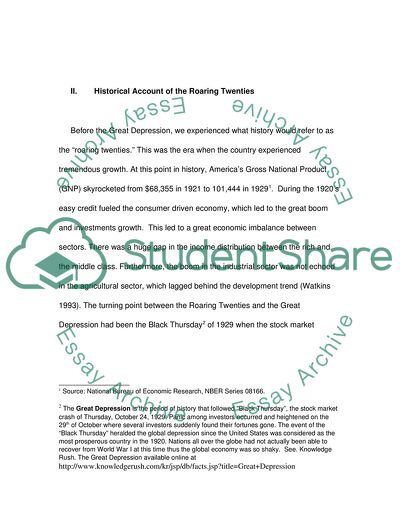
- Home
- Free Samples
- Premium Essays
- Editing Services
- Extra Tools
- Essay Writing Help
- About Us
- Studentshare
- Subjects
- Miscellaneous
- Did the maldistribution of wealth in the prosperity of the 1920's cause us to move from a period of prosperity to the great depression
Did the maldistribution of wealth in the prosperity of the 1920's cause us to move from a period of prosperity to the great depression - Essay Example

- Subject: Miscellaneous
- Type: Essay
- Level: Masters
- Pages: 4 (1000 words)
- Downloads: 0
- Author: albertobosco
Extract of sample "Did the maldistribution of wealth in the prosperity of the 1920's cause us to move from a period of prosperity to the great depression"
To better understand the effects of the maldistribution of wealth and how it affects the purchasing powers of the people consequently amplifying the economic imbalance in the 1920’s; this paper would like to present a clear picture by tracing the important events that happened more than 80 years ago in America. Before the Great Depression, we experienced what history would refer to as the “roaring twenties.” This was the era when the country experienced tremendous growth. At this point in history, America’s Gross National Product (GNP) skyrocketed from $68,355 in 1921 to 101,444 in 19291.
During the 1920’s easy credit fueled the consumer driven economy, which led to the great boom and investments growth. This led to a great economic imbalance between sectors. There was a huge gap in the income distribution between the rich and the middle class. Furthermore, the boom in the industrial sector was not echoed in the agricultural sector, which lagged behind the development trend (Watkins 1993). The turning point between the Roaring Twenties and the Great Depression had been the Black Thursday2 of 1929 when the stock market crashed.
Events such as the massive bank runs in 19333 further aggravated the state of the economy. Yet, long before the stock market crash, there had been telltale signs of economic distress in the US, notably in the falling buying rates of products. Economist attributed this reduced buying capacity to maldistribution of wealth. According to experts, a fundamental maldistribtuion of wealth resulted to uneven purchasing powers in the 1920’s. This factor contributed much to the era of the Great Depression.
To recall, there was a tremendous increase in production in the 1920’s due to industrialization. Notable at this period is the “too rapid increases in productivity versus employment and total wages”(Harris
...Download file to see next pages Read More
- TERMS & CONDITIONS
- PRIVACY POLICY
- COOKIES POLICY